What’s THAT? Ask a Naturalist!
For immediate release ‐ November 18, 2020
Ask a Naturalist
Contact: Jessica Wackes, 919.707.9850. Images available upon request
Eastern Box Turtle | Rat-tailed Maggot | Batfish | Mystery Crystals | Glowworms | Pokeweed | Grass Carp Teeth | Eastern Dobsonfly | Armored Mudballs | Marine Bristle Worm | Black Widow Spiders | Clematis | Hawks at Your Birdfeeder | Fossil Shark Teeth | Copperhead vs. Ratsnake | Baby Orb Weaver Spiders | Hammerhead Flatworm | Eastern Glass Lizard | Buckeye Identification
Do you have a question about a plant, animal or natural object? Be sure to Ask a Naturalist!
Eastern Box Turtle
by Greg Skupien, Curator of the Naturalist Center
One of my earliest memories is of building a giant turtle out of sand in the backyard of my childhood home. The photo of my best friend and I posing next to our work is still one of my most prized possessions. Since then, I’ve had the opportunity to observe and research turtles throughout the southeastern US. Most notably, I spent two summers studying sea turtles on the Georgia coast. As much as I enjoy sea turtles, they are inaccessible to many people. I’ve come to love and appreciate the turtles that we encounter in our own backyards – both those made of sand and the living.
One of the most ubiquitous turtles in the eastern US is the Eastern Box Turtle (Terrapene carolina). The species is found statewide and is the only fully terrestrial turtle found in North Carolina. The Eastern Box Turtle is so widespread and well known that it was selected as North Carolina’s State Reptile in 1979. They are highly variable in appearance. In fact, there are four subspecies of Eastern Box Turtle found in the Southeast, all with a slightly different look. In general, they have a highly domed shell with a hinge on the bottom. When scared, the turtle can completely withdraw into its shell. Freshly hatched turtles are brownish gray with yellow dots and a raised keel down the center of their shell. When hatched, Eastern Box Turtles are only one to two inches long. Adults typically reach five to six inches long but may grow larger.
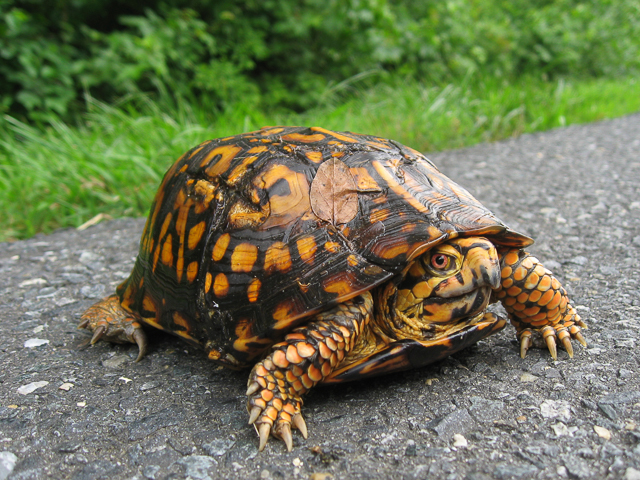 Photo: Jim Lynch/National Park Service. Via Wikimedia Commons.
Photo: Jim Lynch/National Park Service. Via Wikimedia Commons.
The Eastern Box Turtle is omnivorous and feeds on leaves, fruits, mushrooms, insects and other small animals. In turn, adult Eastern Box Turtles are preyed upon by foxes, skunks, raccoons and other mammals. Smaller turtles may also be preyed upon by snakes and birds. The species is still relatively common; however, the Eastern Box Turtle faces a growing number of threats. Domestic animals such as cats and dogs can injure or kill turtles. Increasingly, road mortality, habitat loss and collection for the pet trade have harmed turtle populations.
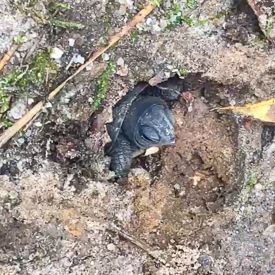
Eastern Box Turtle hatchling emerging from its nest.
Photo submitted to Ask a Naturalist.
Given the increasingly dangerous world for turtles, I was thrilled when a family in Raleigh shared with us a positive turtle encounter from their own backyard. Earlier this year the family observed an Eastern Box Turtle laying eggs behind their house. Females typically lay two to seven eggs in a shallow hole between the months of May and July. The eggs then incubate for 60-100 days. A lot can happen in this time, so the family built a chicken wire enclosure to protect the nest. Most Eastern Box Turtle nests hatch in late August to early October and hatchlings usually emerge from the nest by fall. Some hatchlings overwinter and leave the nest the following spring. The nest enclosure proved effective and in mid-October the family had baby turtles in their yard! The family was rewarded for their efforts. They were able to observe one of the baby turtles emerging from the nest – a truly remarkable encounter in their own backyard.
Solving the Maggot Mystery
by Cindy Lincoln, Naturalist Center Coordinator

Photo submitted to Ask a Naturalist.
I am constantly astonished by the weird and wonderful adaptations insects have evolved to survive in the harshest, most unpleasant (from a human’s perspective) conditions. A perfect example is the rat-tailed maggot identified in this fuzzy image sent to us by a woman in Texas. Rat-tailed maggots are the larvae of the drone fly, Eristalis tenax. These maggots live in stagnant, oxygen-poor water, common in sewage lagoons and cesspools, where they feed on decaying organic matter. At the posterior end of the maggot, is a specialized breathing tube (tail-like structure seen in photos) that allows the larva to stay submerged while it forages for food. The breathing tube can extend many times the length of the maggot allowing it to alternate between shallow and deeper water. I think we can all agree, this is a butt snorkel! Examining maggots at a microscopic level, one researcher discovered thin, sharp spines covering most of the larva’s body. These teeny-tiny spines may help prevent microorganisms, such as harmful bacteria, from colonizing and infecting the maggot — an important advantage if you are swimming in a vat of animal waste.
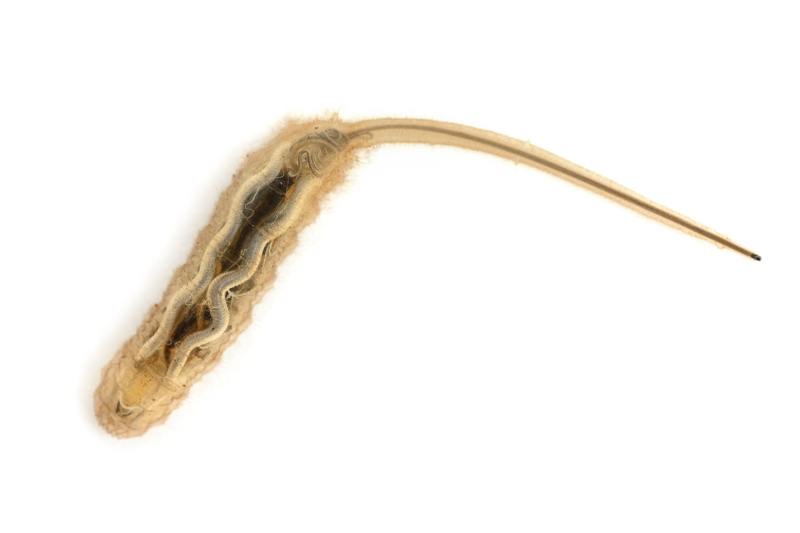
Rat-tailed maggot. (Getty image.)
In sharp contrast to where the larvae live and feed, adult drone flies feed on pollen and nectar and are important pollinators of wildflowers and crops, apparently preferring yellow-flowered plants. Drone flies belong to the family Syrphidae. Flies in this family consisting of thousands of species are sometimes referred to as hover flies, because they can hang in mid-air while searching for nectar. Adult drone flies closely resemble the European honeybee (Apis mellifera). An easy way to distinguish between the two is by counting their wings: honeybees have four while drone flies only have two. Many hover flies closely resemble or mimic bees and wasps. This type of mimicry may help hover flies escape predators; although they are harmless, the hover fly may look enough like a stinging insect that the predator avoids it.
Our deep dive into the world of flies during this year’s BugFest really deepened my appreciation of this group of insects. How can you not be amazed by a fly that uses butt snorkels, spiny armor and mimicry?
Do you have a question about a plant, animal or natural object? Be sure to Ask a Naturalist!
Batty for Batfish
by Greg Skupien, Curator of the Naturalist Center
October has arrived and that means Halloween is just around the corner. The holiday will look and feel a bit different this year, but that hasn’t stopped me from consuming all things pumpkin and starting my month-long binge of scary movies. My toddler has embraced the season, too. Her favorite book at the moment is filled with not-so-spooky ghosts, black cats and bats. I especially love all the bat imagery. If there is one animal that embodies the season for me, it is the bat. With nearly 1,400 species worldwide, bats are important predators and pollinators across the globe. As much as I love bats of the mammalian variety, this post is about bats of the sea, not the sky.
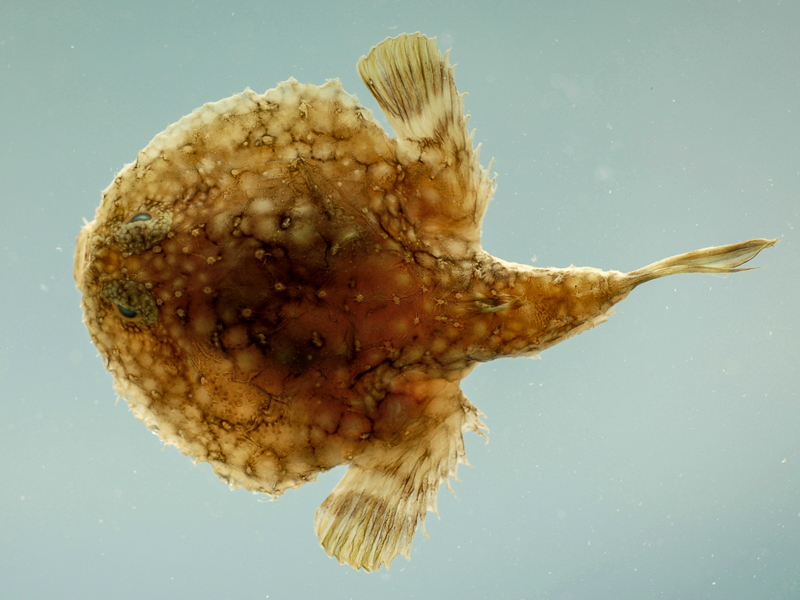 Pancake batfish (Halieutichthys aculeatus). Gulf of Mexico. Photo (edited): SEFSC Pascagoula Laboratory; Collection of Brandi Noble, NOAA/NMFS/SEFSC.
Pancake batfish (Halieutichthys aculeatus). Gulf of Mexico. Photo (edited): SEFSC Pascagoula Laboratory; Collection of Brandi Noble, NOAA/NMFS/SEFSC.
Batfish (such as the one pictured above) belong to the family Ogcocephalidae (Greek, ogkoo, to swell, to enlarge + Greek, kephale = head). There are 78 species of batfish in 10 genera found in tropical and temperate waters around the world. Most batfish have triangular or disc-like flattened bodies. Their fins are modified for life on the ocean floor. Their pectoral fins, located on their sides, are wing-like, giving them their common name. They use these pectoral fins, along with pelvic fins located underneath, to crawl along the bottom of the ocean floor. Given the positioning of their fins, they are poor swimmers. When a predator approaches, batfish rely on camouflage. They flatten their body against the ocean floor and hope they blend in well enough to avoid predation. As a last resort, batfish will flee by quickly scurrying along the ocean floor.
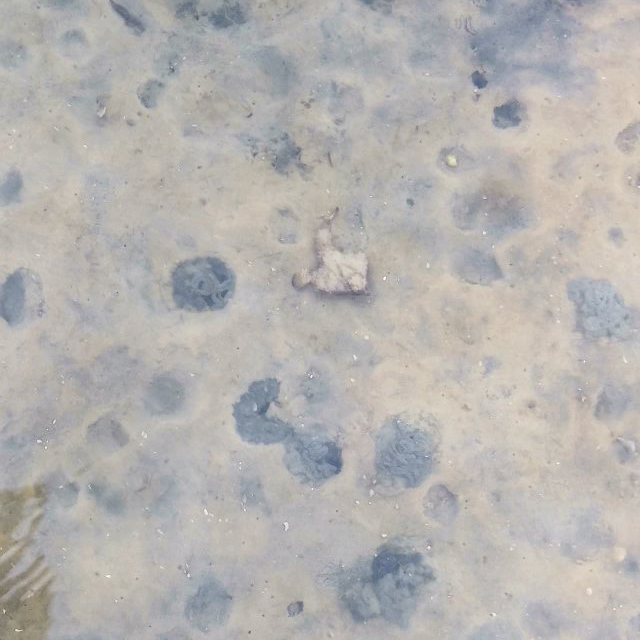 Photo (edited) submitted to Ask a Naturalist. This individual may be a Polka-dot Batfish (Ogcocephalus cubifrons) which is native to the waters of Florida.
Photo (edited) submitted to Ask a Naturalist. This individual may be a Polka-dot Batfish (Ogcocephalus cubifrons) which is native to the waters of Florida.
We recently received a photo (see above) of a batfish from someone vacationing in the Florida panhandle. She witnessed firsthand the batfish’s strange method of locomotion. As she explained, she was wading in clear shallow water along a mudflat when she noticed an odd creature nearby. As the creature approached, she thought that it looked like a fish, but it appeared to be using fins to walk along the ocean floor.
When her photo arrived in my inbox, I immediately recognized it as a batfish. I had seen this animal before. Not in the wild, but in the Museum’s Ichthyology (fish) Research Collection. When I first saw a preserved batfish, I was amazed by its strange body plan. Who knew a fish could look like this? In both life and death, batfish are bizarrely amazing animals. They are members of the order Lophiiformes, better known as the anglerfish. If you know anything about the ocean, you know that the anglerfish are an interesting cast of characters. Like other anglerfish, batfish are equipped with a movable lure at the end of a modified dorsal fin. They can wiggle this lure to attract prey. Unlike other anglerfish, the batfish’s lure isn’t luminescent. Nevertheless, it is an effective way of catching crabs, shrimp, worms, and other prey.
Maybe it’s time we add some aquatic animals to the Halloween season? My vote is for the batfish.
Mystery Crystals
contributed by Cindy Lincoln, Naturalist Center Coordinator
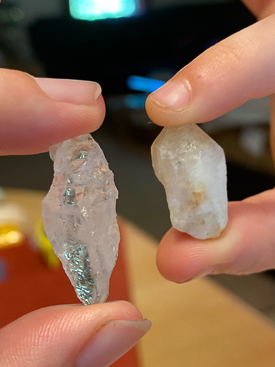
Photo submitted to Ask a Naturalist
What kind of crystal is this (at right)?
We get a lot of questions about rocks and minerals. Thankfully, we have the Museum’s Curator of Geology, Dr. Chris Tacker, who helps us tackle these requests. When the question comes from a child and involves a common rock or mineral, Dr. Tacker frequently offers a stepwise series of tests that can easily be done at home to help narrow down the identification. The photo at right came from a 6-year-old girl (budding geologist according to her parents!) who wanted to know “what type of crystal is this?” and “is it calcite, quartz or glass?” Here are the tests suggested by Dr. Tacker:
- Crystal Form: If the crystal is quartz, the shape when viewed end-on should be hexagonal (like beehive cells).
- Hardness: Use the Mohs Scale of Hardness to determine that calcite is a 3 on this scale while quartz is a 7 (quartz is a harder mineral). A pocketknife (safely use with an adult’s guidance!) can’t scratch quartz, but the knife will scratch calcite.
- Chemical: A drop of vinegar will fizz and bubble on calcite, but not on quartz.
- Cleavage: If you break calcite crystals, you will get rhombohedral cleavage while glass and quartz both exhibit conchoidal fracture.
- Location: Finally, where was the object collected? An interactive map of North Carolina geology will give you some idea what types of rocks and minerals can be found at your location. For example, in the North Carolina Piedmont, several varieties of quartz are very common.
We hope this young geologist was able to carry out these simple tests and identify her find. If you want to try a fun activity to learn more about crystals, try our Science at Home: Eggshell Geode experiment.
Do you have a question about a plant, animal or natural object? Be sure to Ask a Naturalist!
Glowworm Beetles
by Greg Skupien, Curator of the Naturalist Center
Although I am formally trained as a herpetologist (someone who studies reptiles and amphibians) I’ve recently taken more of an interest in creatures of the buggy kind. In part, this newfound interest is due to a recent work-from-home project of mine. I have been cataloging the Naturalist Center’s insect collection, assigning each pinned specimen a unique number and entering data into an online database. I’ve also used my additional time at home to explore the creatures living in my yard. On many nights, I hang a blacklight in front of an old bedsheet and see what comes to visit. There have been numerous times when I’ve seen an arthropod in the collection or the yard and thought, “What in the world is that?!” In my opinion, there are few other groups of animals that can elicit such a response. I may not always know what species of snake I am looking at, but at least I know it’s a snake. With arthropods, it’s a different story!
Last summer, we received a submission via Ask a Naturalist that had me stumped. I truly had no idea what I was looking at in the photo. Fortunately, our resident entomologist, Dr. Colin Brammer, was quickly able to identify the animal as a glowworm beetle in the family Phengodidae. I find glowworms fascinating because the adult females are larviform. This means that the adult females resemble the young of the species and are often impossible to differentiate from full-grown larvae.
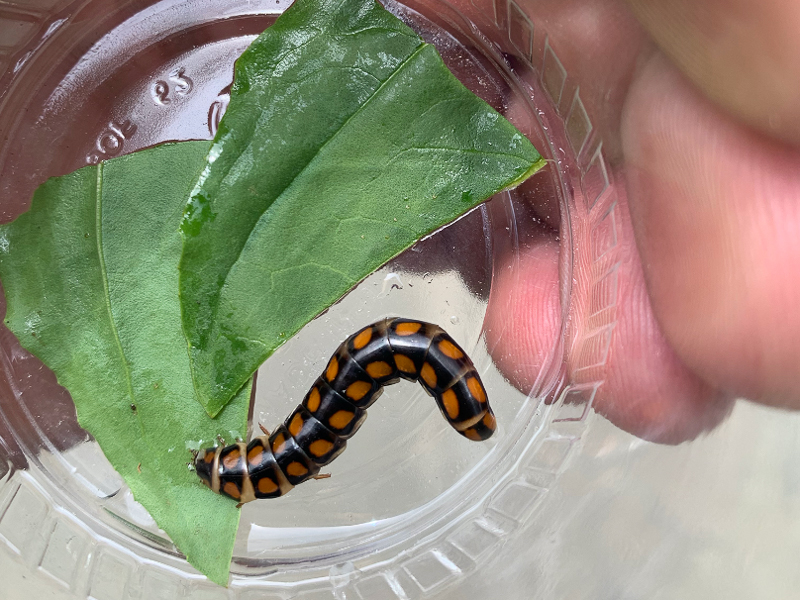
Adult males more closely resemble what we expect a beetle to look like, but with short elytra (wing coverings) and branched antennae:
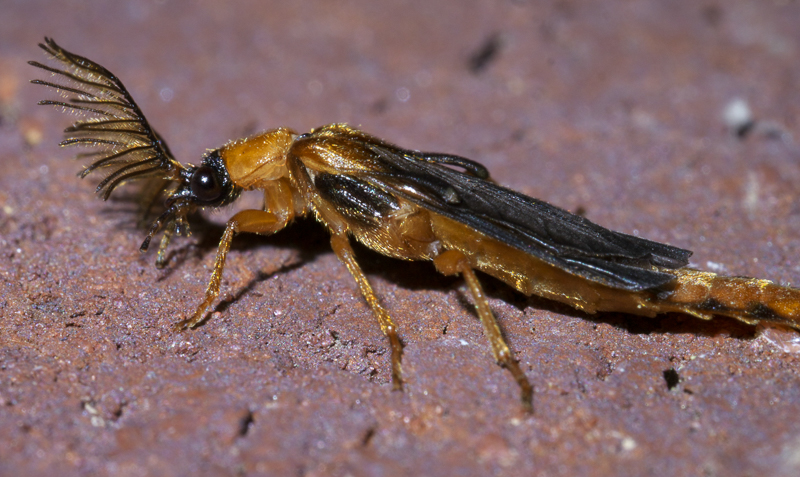 Photo: Robert Webster / xpda.com / CC-BY-SA-4.0.
Photo: Robert Webster / xpda.com / CC-BY-SA-4.0.
As the name implies, glowworm beetles glow. Typically, only the eggs, larvae, and adult females glow, but in some species the adult males glow as well. Insects that are active during the day use bright colors to advertise the fact that they are poisonous (think bright orange Monarch Butterfly). At night, in the absence of light, bright colors would be useless. By glowing, glowworm beetles advertise their distastefulness as a warning sign to predators.
Glowworm beetles are rarely encountered so finding one is always special. With their striking black and red bodies and their ability to glow, they are quite the sight when seen. For more fascinating arthropod observations, join me and Museum entomologist Colin Brammer on Saturday, September 19 from 4pm to 5pm for Ask a Naturalist: Arthropod Edition. We will share past Ask a Naturalist submissions and learn more about the amazing world of arthropods. You can even submit your own observations and see if you can stump our expert. The program is part of BugFest: A Virtual Infestation.
Do You Know What Kind of Plant This Is?
by Cindy Lincoln, Naturalist Center Coordinator
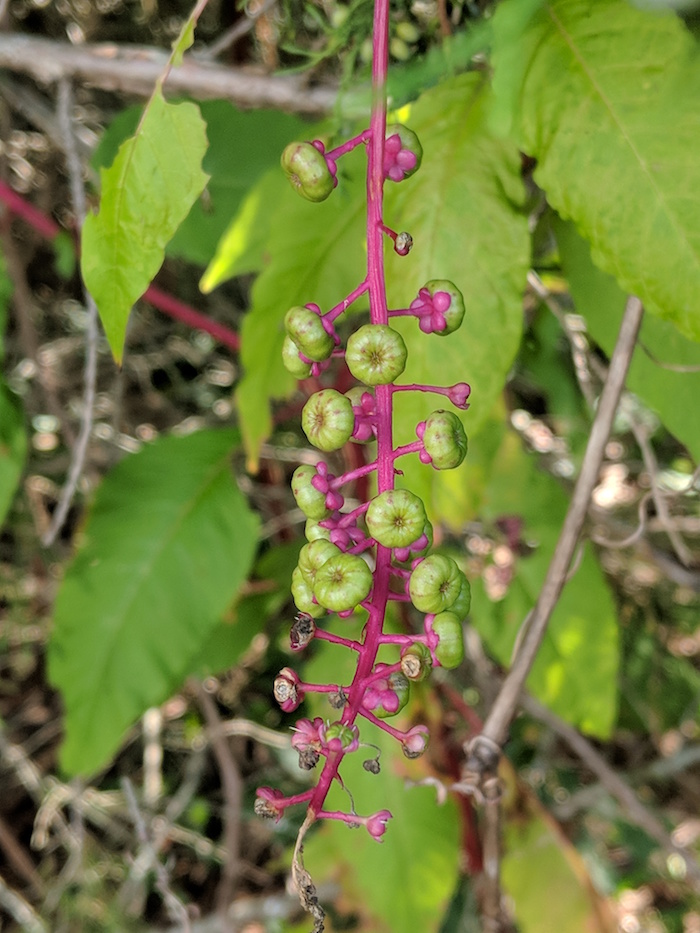
Unripe Pokeweed Berries. Photo submitted to Ask a Naturalist.
Have you been on a walk around your yard or neighborhood recently and noticed an odd-looking plant that seems to have appeared overnight and is growing with alarming speed? Say hello to pokeweed! Phytolacca americana goes by a variety of common names including pokeweed, poke root, poke berry, dragonberries and poke sallet. This aggressive perennial can grow as tall as 6 to 8 feet and favors open or edge habitats. Like many weeds, it isn’t very picky about soil type or amount of sun. In addition to being spread by birds who love to eat the ripe, dark purple berries, the plant can overwinter by producing a large, deep taproot. I go to battle with pokeweed in my garden every year and think that I’ve been victorious only to see it re-emerge the following summer.
Pokeweed is considered an edible native plant and has been part of the culture and cuisine of the south for a long time. The young shoots and leaves, when prepared properly, are used to create a traditional dish called poke salad (or poke sallet). However, extreme caution is warranted! From root to fruit, all parts of the pokeweed are poisonous. The berries are especially toxic in both the unripe (green) and ripe (purple) stages and may be tempting to small children or pets. Leaves and stems can be safely eaten only when they have been rinsed and boiled at least twice with clean, fresh water each time. The ripe berries can be used to make a lovely red ink or dye, but care must be taken not to expose your skin directly to the berry juices or resulting dye.
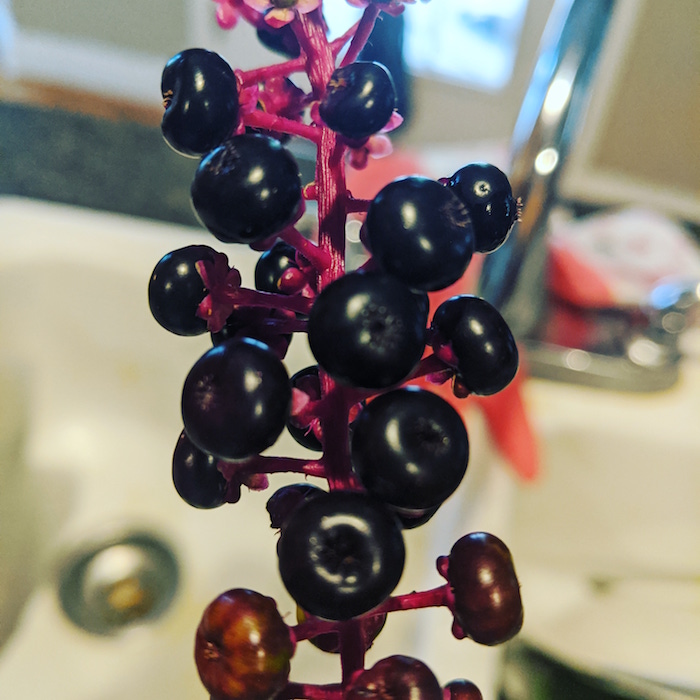
Ripe Pokeweed Berries. Photo submitted to Ask a Naturalist.
Is there anything about this weedy, toxic plant to love? Birds think so with over 30 species using pokeberries as an important food source. Raccoons, opossums and foxes may also tolerate the pokeweed toxins and enjoy an occasional berry snack. Finally, pokeweed is the host plant for giant leopard moth caterpillars. So, if you have a corner of your yard away from pets and kids, leave a pokeweed or two and feed the wildlife! Do you have a question about a plant, animal or natural object? Be sure to Ask a Naturalist!
Grass Carp Pharyngeal (Throat) Teeth
by Greg Skupien, Curator of the Naturalist Center
The first time I saw the teeth of a grass carp (Ctenopharyngodon idella), I was thoroughly confused. It was 2015 and I had just started working at the Museum. I knew very little about fish, so I decided to explore the Naturalist Center’s fish collection. As I was going through the drawers, I came across a set of teeth that looked more alien than fish-like. It was one of those specimens that made me stop everything and learn more.
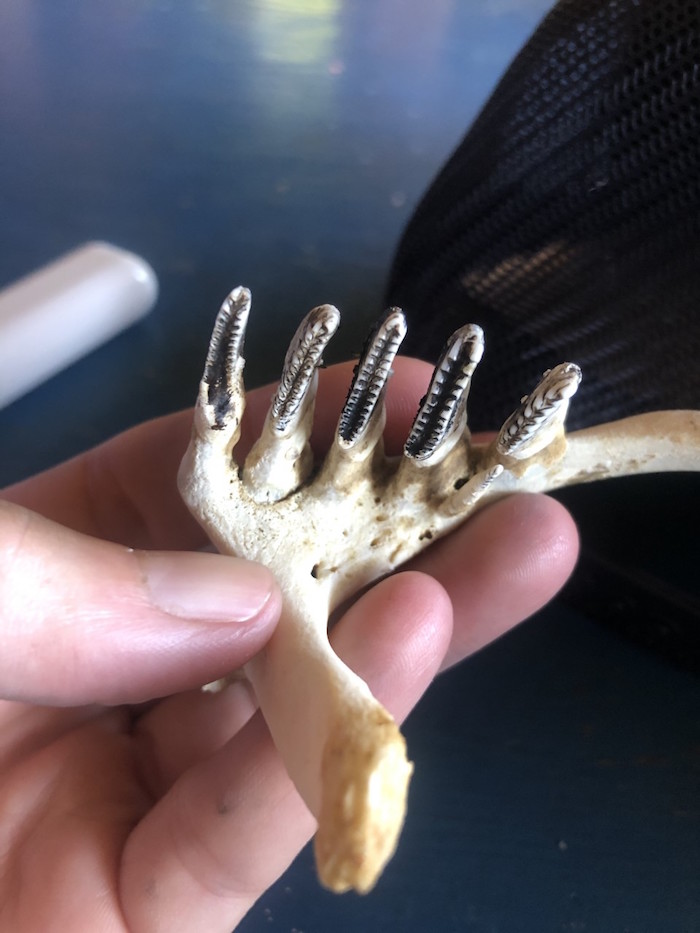
It came as no surprise to me that a mother and son would find these teeth equally as perplexing. Recently, the two were exploring the banks of the Neuse River in Arapahoe, NC, when they came across a strange set of teeth. They collected the specimen and sent us photos for identification (above).
I instantly recognized the teeth as those of the grass carp that had awed me years before. Grass carp have pharyngeal teeth that are in the back of their throat. The teeth are actually highly modified gill arches. Gill arches are a series of bony structures that support the gills. In the grass carp, the fifth and last gill arch develops into pharyngeal teeth. They use these throat teeth to mechanically process plant material. As the plants move down the throat the pharyngeal teeth crush and grind it into digestible pieces.
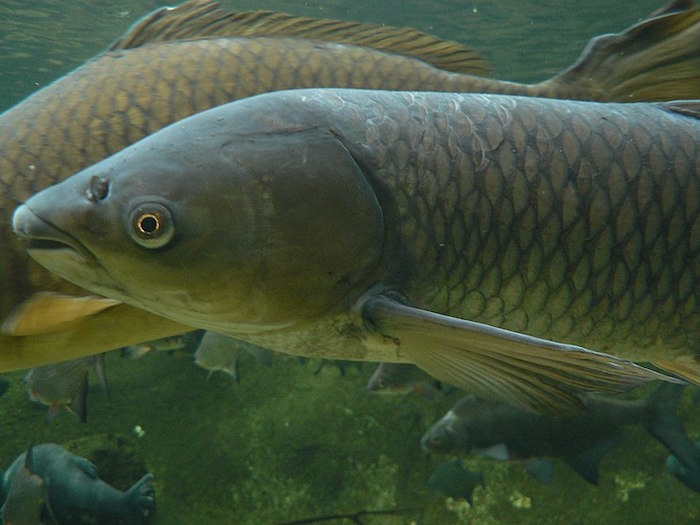 Photo by Peter Halasz.
Photo by Peter Halasz.
The grass carp is a nonnative species that was introduced from Eastern Asia. The species is known for its voracious appetite and is used for biological control of aquatic vegetation. It was first imported to the United States in 1963 to aquaculture facilities in Alabama and Arkansas to control hydrilla and other aquatic plants. Since then, the species has spread rapidly as a result of research projects, intentional release, natural dispersal and other means. Grass carp have now been reported in 45 states. They were first observed in North Carolina in 1980.
Grass carp live in freshwater lakes, ponds and rivers. They can also tolerate low levels of salinity and may enter brackish waters. The grass carp’s effects on these systems is complex and can be severe. Negative impacts include competition with other species, elimination of shelter, and alteration of food webs. To mitigate these negative impacts, sterile grass carp have been developed by exposing eggs to extreme heat stress or pressure. The sterile fish cannot reproduce but maintain their insatiable appetite for aquatic vegetation. This allows the grass carp to put their strange teeth to good use while limiting their spread.
What Kind of Fly is This?
by Cindy Lincoln, Naturalist Center Coordinator
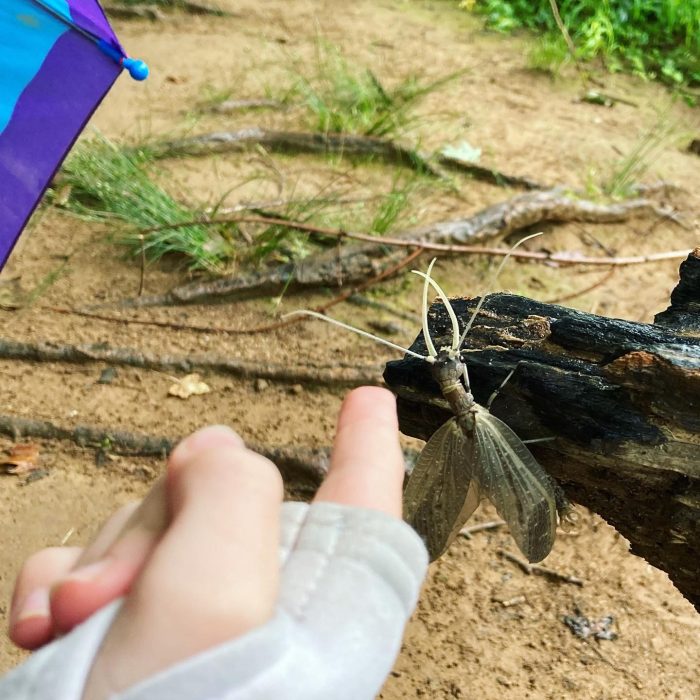
This newly emerged male Eastern Dobsonfly (Corydalus cornutus) has not quite reached his full adult length of 4-5 inches, but he is already displaying an impressive set of long, sickle-shaped mandibles. Dobsonflies belong to the Order Megaloptera (“giant-winged insects”) and often elicit fear and fascination because of their large size and these tusk-like “jaws.” Surprisingly, the mandibles (modified mouthparts) of the male dobsonfly are not used for defense and will not inflict a painful bite should you decide to waggle your finger in front of one. Instead, the male’s mandibles are used for courtship and mating rituals with female dobsonflies. Females have much smaller and stronger mandibles, but neither males nor females use their powerful-looking jaws for feeding or predatory behaviors. Adult dobsonflies have a very short life-span (1-3 days for males and 8-10 days for females) and spend their time mostly focused on reproduction.
The range of dobsonflies includes most of eastern North America from Canada to Mexico and they are common in North Carolina. Because clean, flowing water plays an important part in their life cycle, dobsonfly habitat requires proximity to streams and rivers. In fact, this photo submitted to Ask a Naturalist was taken along the Eno River. Juvenile or larval dobsonflies begin their aquatic life after hatching from eggs deposited on plants next to or overhanging a stream or river. Dobsonfly larvae are called hellgrammites — a fierce sounding name that totally fits these ferocious, 4-inch long creatures that look like underwater centipedes. Hellgrammites spend 1 to 3 years living beneath stones and under vegetation in swift flowing water. They are one of the top invertebrate predators found in streams and rivers and voraciously eat smaller aquatic insects such as immature mayflies, stoneflies and caddisflies. Hellgrammites thrive in well-oxygenated, unpolluted water so their presence is often used as an indicator of a healthy stream ecosystem. The body of a hellgrammite is well-designed for its amphibious lifestyle. Both sides of their abdomen are lined with two types of gills that allow larvae to extract oxygen from the water they live in. Their exoskeletons have spiracles (openings or breathing holes) that allow the hellgrammite to breath air on land — this is critical because they must crawl out of water to create a chamber in moist soil or under a stone or log in order to pupate and transform into an adult dobsonfly.
Excited to learn more about flies and other insects? Plan to attend BugFest: A Virtual Infestation! This year’s theme arthropod is the FLY. From September 14th to 19th, the Museum will offer an online extravaganza of insect-related activities, games and presentations. Do you have a question about a plant, animal or natural object? Be sure to Ask a Naturalist!
Armored Mudballs!
by Greg Skupien, Curator of the Naturalist Center
The ocean is a vast and mysterious place teaming with life and the signs of past life. A beachcomber, or a casual vacationer, can discover some of the mysteries of the ocean by simply taking a walk down the beach. Seashells are the most commonly sought-after treasures, but many other unique finds await the curious observer.
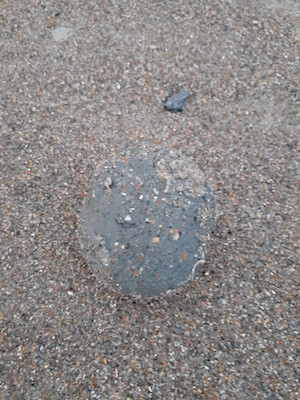
On one of my first trips to the Atlantic Ocean, I found a squishy pink blob just feet from the breaking waves. At the time, I had no idea if this thing was a plant, animal or mineral. Turns out it was a type of marine invertebrate known as a Sea Pork. To this date, I don’t really understand this strange animal, but that beach encounter left a lasting mark on me and cultivated a deep curiosity for the beach. As such, it’s always fun to receive ‘Ask a Naturalist’ questions from the beach. We recently received such a request about an object discovered on the south end of Topsail Island.
This spherical gray ball had us confused at first. However, after a few books and a quick consultation with our geologist we confirmed that this beach orb is a mudball. Beach mudballs are globs of clay, sand and other debris. The clay is cohesive, forming clumps that are rolled around in the current until a round ball is formed. Mudballs that roll around in shells are known as armored mudballs. Little bits of shell get stuck to the exterior and create a layer of armor. Armored mudballs typically last longer than other mudballs before disintegrating in the surf.
Mudballs can be found in rivers where a clay bank gets undercut. In the ocean, they originate from highly compacted marsh sediments of clay or mud that sit under some beaches or just offshore. Storms frequently expose and erode these deposits of clay or mud. The eroded clay or mud is then tumbled into spheres by waves, creating the mudball. Waves often carry the mudballs to the shore, but humans may also provide a helping hand. Beach replenishment, or nourishment, is a technique that is used to rebuild beaches and protect coastal development by pumping sand onto the shoreline to widen the beach. Pumping sediment to the beach is a quick way for a mudball to wind up in the path of a curious beachcomber. In this case, south Topsail Island had just finished a beach replenishment project. It’s likely that this mudball found its way onshore thanks to this process.
Regardless of how the mudball arrived, the beach continues to provide of wealth of interesting finds. From pink blobs to gray balls, if you make an interesting discovery be sure to send it our way. We’ll be happy to help identify all of your beach mysteries.
If you need help identifying a specimen, please reach out to us at Ask a Naturalist.
What Kind of Worm is This?
by Cindy Lincoln, Naturalist Center Coordinator
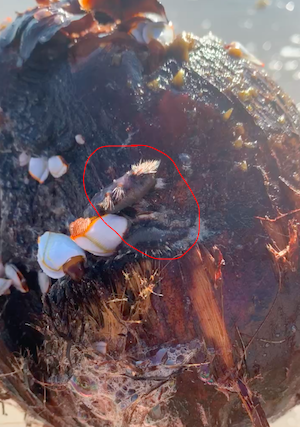
We recently received a video taken along the beach at Fort Macon State Park that led us on an interesting journey into the world of polychaete worms. “What is that brown, prickly worm thing?” the sender asked. After puzzling over an image that to us looked like a fat, coffee bean-colored caterpillar wrapped around a gooseneck barnacle on a coconut, we knew some expert consultation was needed. Our Curator, Dr. Bronwyn Williams, and Collections Manager, Megan McCuller, from the Museum’s Non-molluscan Invertebrate Unit identified it as a polychaete worm. Further confirmation came from Dr. Geoff Read, a marine biologist and polychaete expert based in New Zealand, who offered the identification of Amphinome rostrata or marine bristle worm. This particular bristle worm species preys upon goose barnacles often attached to drift objects (in this case, a coconut, the most common ocean drift fruit) throughout tropical oceans worldwide. Our coconut-riding bristle worm may have gotten a little too much sun exposure resulting in its abnormal color.
 Photo credit to Dr. Bronwyn Williams
Photo credit to Dr. Bronwyn Williams
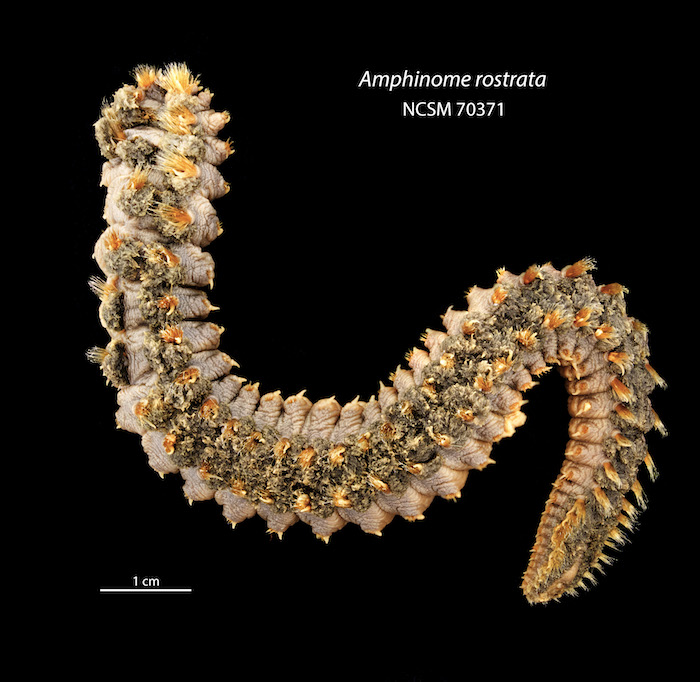 Photo credit to Dr. Bronwyn Williams
Photo credit to Dr. Bronwyn Williams
Polychaetes are a large, highly diverse class within phylum Annelida with approximately 10,000 mostly marine species. Along with a head and tail, these worms are characterized by segmented bodies with rows of spiny hairs or bristles along each side (polychaete means “many hairs”). The bristles are attached to tiny leg-like appendages called parapodia. Each body segment contains one pair of parapodia as beautifully illustrated in the photographs of a preserved marine bristle worm from the Museum’s Non-molluscan Invertebrate Collection. The shape of the parapodia vary depending on the species and whether the worm is a crawler, swimmer or burrower. For example, sedentary feather duster worms live in tubes buried in sand or mud; their specialized parapodia are used to move them up the tube to filter feed or down to hide from predators. The types of bristles found on polychaete species also vary and may protect the worm from predators. The most extreme example is the fireworm whose bristles contain a mild neurotoxin that can cause intense pain if one of the bristles penetrates your skin.
Let me introduce you to a few of the most bizarre polychaetes. First up, the sand striker worm. Reaching up to 10 feet in length, these worms are stealth predators, concealing themselves under the ocean floor then shooting out and snatching unsuspecting prey with scissor-like jaws. Next, meet the Pompeii worm, a deep sea polychaete that lives in Pacific Ocean hydrothermal vents and tolerates temperatures in excess of 140 degrees F while bathing in toxic heavy metals and sulfides. Finally, there are the Osedax or zombie worms that feast on the bones of whale carcasses that sink to the ocean bottom; the scientific name of one species, Osedax mucofloris, literally means “bone-eating snot flower”.
Now that you have learned about bristle worms and are ready to celebrate their wonderful weirdness, you are in luck. July 1st is INTERNATIONAL POLYCHAETE DAY! This day was set aside to recognize the late Dr. Kristian Fauchald, a research zoologist who focused on polychaetes, naming almost 300 species during his tenure at the Smithsonian National Museum of Natural History, from 1979 until his death in 2015.
Do you have a question about a plant, animal or natural object? Be sure to Ask a Naturalist!
Black Widow Spiders
by Greg Skupien, Curator of the Naturalist Center
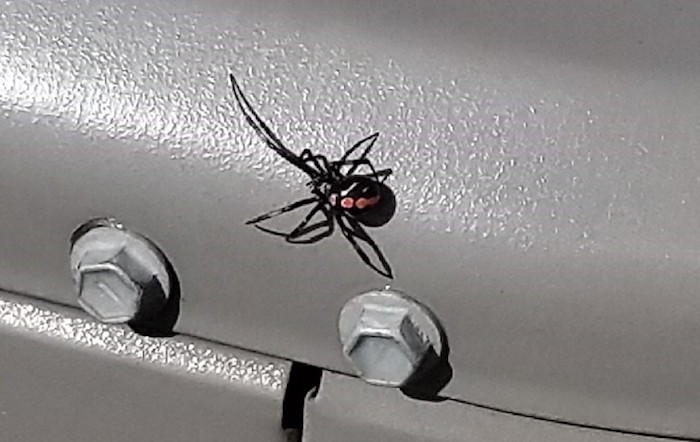
An image submitted through the Ask a Naturalist Form.
In 2011, I moved to the Southeast to begin work as a wildlife biologist. I quickly got in the habit of shaking out my boots to reduce my chances of stepping on any spiders that might be hiding inside. While in Georgia, I had plenty of interactions with alligators, snakes and biting insects, but I never found a spider hanging out in my boots. It wasn’t until I relocated to North Carolina that I found a venomous spider in one of my shoes. Before putting them on, I shook out a pair of rain boots and out fell a beautiful Southern Black Widow Spider. She fell to the ground motionless. I thought she was dead, so I swept her out of the garage and onto the driveway. Only later did I learn that when disturbed a Black Widow may play dead. In this case, I had likely scared her as much as she had startled me and she decided to feign her death.
There are five species of Widow Spiders (Latrodectus spp.) in the United States. The two that are most commonly found in North Carolina are the Northern Black Widow (Latrodectus variolus) and the Southern Black Widow (Latrodectus mactans). The Brown Widow (Latrodectus geometricus) is believed to be native to Africa but was introduced into the United States. It is currently uncommon in North Carolina.
Many people can easily identify a Black Widow Spider. Adult females (pictured below) are shiny black with a round body. They are notorious for the red hourglass mark on the underside of their abdomen. Identifying immature and male widows can be much more challenging, such as this young spider submitted to us via our Ask a Naturalist form. Young females lack an hourglass but may have orangish-red spots on their abdomen. They change into the recognizable Black Widow Spider with each successive molt of their exoskeleton.

Males (pictured below) are smaller than females and have longer legs relative to their body. Males may also have red, white or orange markings on their abdomens.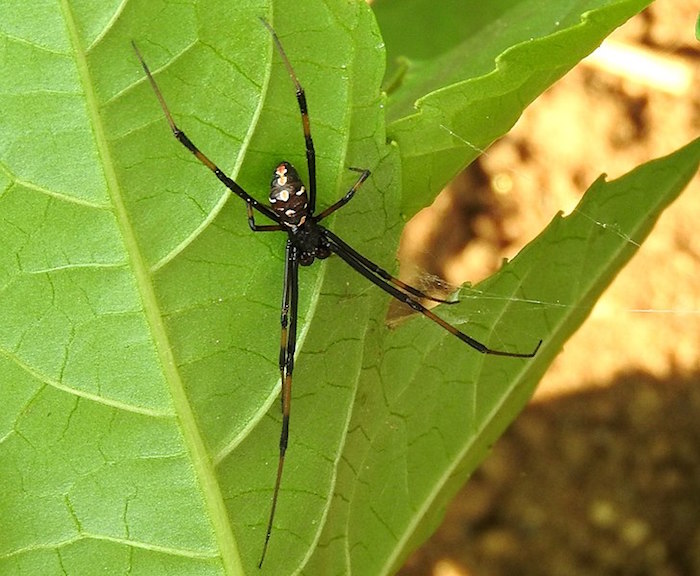
Black Widow Spiders typically live in dark, sheltered spots close to the ground such as under logs, in crevices, in garages and in barns. At times, these spiders can even be found in shoes or clothing, such as in my experience. In these places they create strong webs without a distinguishable pattern and feed on insects and other small invertebrates. Once a prey item is entangled, the spider bites into it and injects digestive enzymes. The prey breaks down and the spider sucks up the liquified food. The web also plays an important part in reproduction. A male Black Widow Spider vibrates the web to make sure he has found a female of the correct species and to make the female more receptive to mating. Contrary to their name, female Black Widows do not always eat their mates. In fact, in some species of widows this behavior has never been seen in the wild. Eggs are laid and covered with silk until they are completely covered in a beige sac. The eggs incubate for about one month until the spiders hatch. Most spiderlings will die from cannibalism. If they make it, females survive for 1.5 years on average and males for around two to five months.
On occasion, Black Widows may bite humans in an act of self-defense. Only adult females can inflict a painful bite to humans. Immature spiders and males are harmless to humans. Most bites occur when the spider is pressed against human skin, such as when putting on gloves or shoes containing a spider. Their venom is neurotoxic and causes a multitude of symptoms collectively known as latrodectism. Symptoms may include localized swelling, muscle pain, abdominal cramping and/or impaired breathing. A Black Widow Spider bite is rarely fatal. The impacts are largely dependent on the age and health of the person who was bitten.
Of course, it’s best to take precautions and avoid spider bites altogether. Get in the habit of shaking out shoes and work gloves, especially those that have been stored in a garage or shed. Pay extra attention when working in areas where Black Widow Spiders may be established. If bitten you should contact your doctor or a poison control center immediately. The Poison Control hotline can be reached anywhere in the United States by calling 1.800.222.1222.
Do You Know What Kind of Flower This Is?
by Cindy Lincoln, Naturalist Center Coordinator
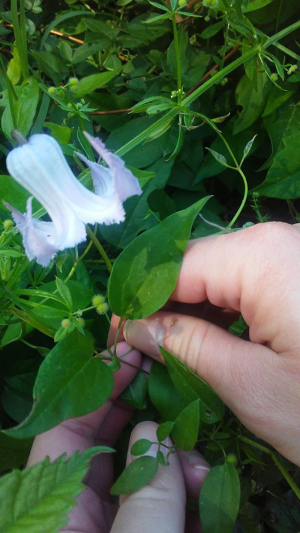
Clematis crispa. Photo submitted to Ask a Naturalist
For gardeners, the name “clematis” evokes images of a vine with large, spectacular pink, purple or white blooms coiling around a mailbox or spiraling up a trellis. The Clematis genus contains around 300 species and thousands of cultivars. A cultivar is a plant variety that is produced through breeding or selection to have distinct characteristics. The origin of these large-flowered clematis cultivars (some with blooms up to 10 inches in diameter!) began through crossing or hybridizing Clematis species from China and Japan; some of the earliest cultivars were introduced in the 1800s. The astonishing thing about Clematis flowers is that they are “apetalus” meaning no petals—their color is provided by the sepals and stamens.
But what about native Clematis species that haven’t been tinkered with by humans? Clematis species can be found growing in diverse habitats ranging from alpine meadows to tropical rain forests and occur in both northern and southern hemispheres. North Carolina has a number of native species such as Clematis crispa shown in this photo taken in Bladen County and submitted to Ask a Naturalist. Also known as Swamp Leather Flower, Clematis crispa is a perennial vine that grows in marshes, swamps, floodplains and other wet areas. In contrast to the flamboyant blossoms of the Clematis hybrids, Swamp Leather Flower sparingly produces small, delicate, bell-shaped blooms from April to July. The sepals of these blooms can be blue, pink, violet or white and have “crispate” margins — another botanical term meaning wavy or curly edges. In the fall, flowers turn into crazy, fluffy-looking fruits (seed heads), each seed having a long, wavy, feathery tail. The leaves, flowers and fruits of Swamp Leather Flower provide food for wildlife including insects (such as caterpillars, butterflies and bees) as well as birds (such as hummingbirds) and this plant is listed on Audubon’s 700 Bird-friendly Native Plants for North Carolina.

Clematis hybrid. Photo by Cindy Lincoln
Before you run out to purchase and plant Swamp Leather Flowers or other Clematis in your yard, there are a few important things to keep in mind. Swamp Leather Flower requires a very specialized habitat to do well and needs consistently moist soil which may be difficult to duplicate in an average landscape. There are some Clematis species like Clematis virginiana (native to eastern North America) and Clematis terniflora (non-native) that produce masses of lovely, fragrant blooms, but are both weedy and highly invasive. Finally, leaves and sap of all Clematis are toxic to dogs, cats and humans. Even so, there are many compelling reasons to use this vine in your garden and thousands of Clematis to choose from! Do you have a question about a plant, animal or natural object? Be sure to Ask a Naturalist!
Hawks at Your Bird Feeder
by Greg Skupien, Curator of the Naturalist Center
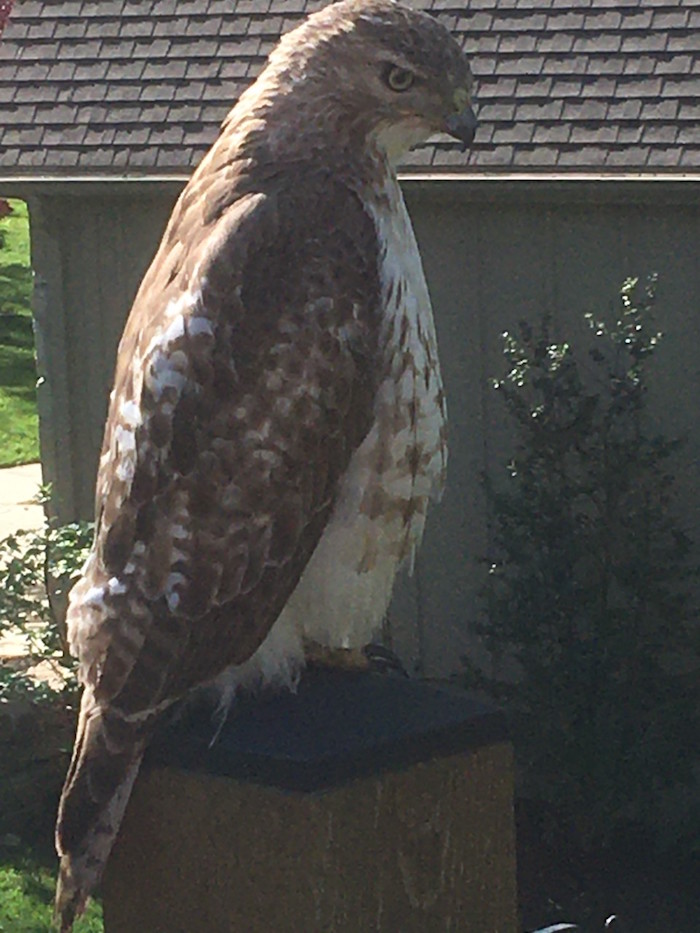
Backyard birding is a wildly popular hobby in the United States. The U.S. Fish and Wildlife Service estimates that more than 45 million Americans watch birds around their home or in other locations. Each February, the Audubon Society takes advantage of these backyard birders and encourages people to take as little as 15 minutes to count and report their bird sightings during the Great Backyard Bird Count. This year, over 250,000 people participated across the globe and documented close to 7,000 species of bird. The most commonly reported species was the Northern Cardinal. Blue Jays, Doves, Finches, Juncos and Woodpeckers followed close behind.
Being a backyard birder myself, it’s always a great joy to watch this familiar cast of characters coming and going at my bird feeders. However, it’s particularly exciting when a large bird of prey makes a visit to the backyard. Recently, I briefly encountered a hawk in the yard as I ate dinner outside. To my wife’s displeasure, I interrupted her mid-sentence to exclaim in excitement as the hawk zoomed past in pursuit of a smaller bird. That hawk was likely a Cooper’s Hawk (Accipiter cooperii). The Cooper’s Hawk, and the similar-looking Sharp-shinned Hawk (Accipiter striatus), are more commonly seen in backyards than other birds of prey. They are skillful flyers, navigating forest canopies to catch and eat small birds such as the ones that gather at bird feeders.
It’s clear that other people share a fascination for large birds of prey. The Museum frequently receives requests to identify hawks and other birds of prey. A recent “Ask a Naturalist” submission of a large hawk perched on someone’s porch came to us all the way from Kansas. The hawk in question was identified as a Red-tailed Hawk (Buteo jamaicensis), one of the most common hawks in North America. The Red-tailed Hawk is a large bird with a wingspan up to 52 inches and weight around 3 pounds. The species is found across the United States and Canada south into Mexico and Central America. Although they are widespread, Red-tailed Hawks are uncommonly found in backyards (unless you have a large yard). They are more typically found soaring above open fields in search of food. Red-tailed Hawks primarily eat small rodents such as mice, rabbits and squirrels. They may also consume birds, snakes and carrion. Red-tailed Hawks are also frequently seen perched atop trees or telephone poles.
Like many others, I find backyard birdwatching to be an enjoyable hobby. It wasn’t until recently that I began keeping track of the species that visit my yard. I now submit these observations to websites like iNaturalist and eBird in hopes that they may be of scientific value. If you’re a backyard birdwatcher, consider submitting your observations to one of these sites and be sure to make plans to participate in the Great Backyard Bird Count next February. If you need help identifying a backyard bird, please reach out to us at Ask a Naturalist.
Fossil Shark Teeth!
By Cindy Lincoln, Naturalist Center Coordinator
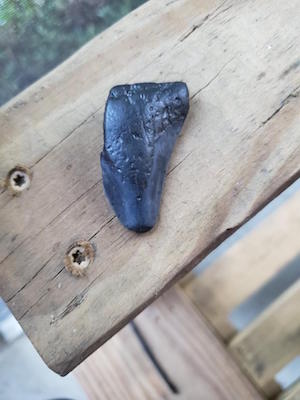
Photo submitted to Ask a Naturalist.
Normally, with warmer weather and vacationers heading to the North Carolina coast, we see an increase in the number of requests to identify fossil shark teeth. This fossil Megalodon tooth, submitted to Ask a Naturalist, was found along Wrightsville Beach near Wilmington. A larger, more complete Megalodon tooth measuring over 5.5 inches long was discovered last summer at Ocean Isle Beach; both beaches are popular tourist destinations. Many agree that Topsail Island offers the best beaches to find fossil shark teeth, although beach renourishment projects occurring regularly along our coast can affect beachcombing success. Searching at low tide or after storms usually increase your odds of finding interesting fossils.
Identifying the species of shark tooth can be challenging even for a knowledgeable collector. Fossil shark teeth, such as the one in the photo, are frequently broken or worn by constant tumbling in the surf. Within a single species of shark, teeth vary depending on jaw location, whether the tooth came from an adult or baby shark or from a female or male shark. Numerous ancient shark species existed during the Miocene epoch (24–5.3 million years ago) and fossil shark teeth from this geologic time period are commonly found along NC beaches.
This is partially due to the constant action of waves naturally exposing what has been buried deep underground. To understand and visualize how the Atlantic coastline has changed over millions of years, I recommend visiting paleoportal.org. This website, funded by the National Science Foundation, has an interactive map that allows you to view fossil formation across North Carolina (and other states) during geologic time periods spanning many millions of years.
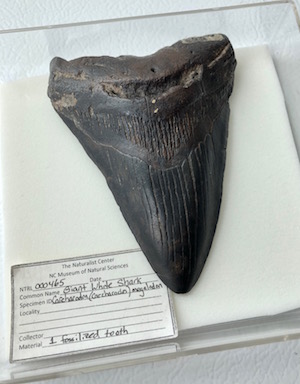
Fossil Megalodon Tooth from Naturalist Center Collection.
We always enlist the help of one of the Museum’s expert paleontologists when answering any fossil question. For a beginner, consider joining a fossil club (NC Fossil club is a great one) or participate in a Citizen Science project like Shark Tooth Forensics. Finding a complete Megalodon tooth is very rare. The color of these fossil teeth, frequently black, depends on the conditions and minerals present when the tooth became fossilized. The massive size of Megalodon teeth has been used to estimate the body length of this now (definitely!) extinct shark at over 50 feet long, making Megalodon one of the largest carnivores to have ever lived! Regardless of size, condition or species, finding and holding a fossil tooth that is many millions of years old can be the thrill of a lifetime!
Copperhead? Guess Again.
by Greg Skupien, Curator of the Naturalist Center
 A submitted photo of a ratsnake.
A submitted photo of a ratsnake.
“What type of snake is this?” and “Is this a Copperhead?” are two of the more common questions we receive through “Ask a Naturalist.” As warmer weather sets in and snakes become more active these questions will only increase in frequency. Understandably, people are concerned that there may be a venomous snake living in or around their property. Fortunately, it is often a case of mistaken identity.
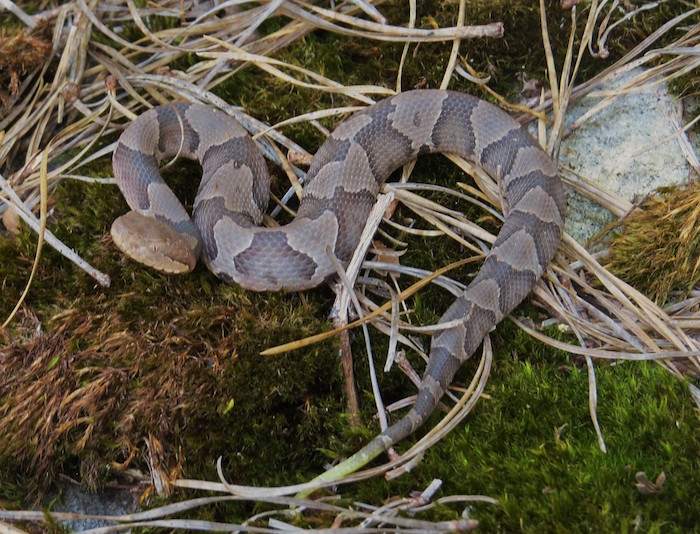 This is a Copperhead.
This is a Copperhead.
One of the species most commonly mistaken for a venomous snake is the Eastern Ratsnake (Pantherophis alleghaniensis). The Eastern Ratsnake is a harmless (i.e. nonvenomous) species that does well in and around human dwellings. As such, they are the most commonly encountered large snake in North Carolina. On average, an adult Eastern Ratsnake can reach 3 to 6 feet in total length. They are skilled climbers and can be found scaling trees in search of prey or a place to bask in the sunlight. The Eastern Ratsnake primarily eats small rodents and birds, but may also consume other reptiles and amphibians. They are sometimes referred to as “Chicken Snakes” because they may raid chicken coops to eat the eggs.
In North Carolina, female Eastern Ratsnakes lay 5–28 eggs in the summer and the babies hatch from August to October. Young snakes are patterned with dark brown or black patches on a lighter gray background. It is in this early life stage that the Eastern Ratsnake is most often confused for the venomous Copperhead. In contrast, the Copperhead has dark brown hourglass markings on a light brown background. When viewed from the side the Copperhead’s pattern may resemble a Hershey’s Kiss. A Copperhead’s color may vary and appear more reddish orange, but their distinctive pattern remains.
Eastern Ratsnakes vary more widely in color pattern. As they grow older, Eastern Ratsnakes living in the mountains and Piedmont will often lose their juvenile patterning and become solid black. For this reason, people often refer to this species as the “Black Snake.” In the Coastal Plain, adults are often yellow with dark stripes.
Due to their color variability, Eastern Ratsnakes may be difficult to identify. When in doubt, ask an expert for help. If you find a snake and don’t know what it is, keep a safe distance. Never harass any snake. Don’t try to pick it up or kill it. If you can, safely take a photo and submit it to “Ask a Naturalist.” We’ll be happy to help identify the snake for you.
Baby Orb-Weaver Spiders!
by Cindy Lincoln, Naturalist Center Coordinator
When a Gaston County school teacher noticed this mass of wriggling, tiny, yellow dots on a dried- up leaf in his backyard, he began to investigate. These moving dots looked a lot like itty-bitty spiders! But what kind of spider? Using the excellent photos and video he submitted to Ask a Naturalist, we consulted with Museum entomologist, Dr. Colin Brammer, who determined that these spiderlings (technical term for immature spiders) are the offspring of an Orb-weaver spider. All spiders mature in three stages: egg, spiderling and adult. Spiderlings look just like the adult spider but are much smaller (roughly the size of a corn kernel) making it very difficult to identify the type of Orb-Weaver spider from photos alone. As each spiderling grows, it will repeat a process of shedding its exoskeleton (molting) several times before reaching adult size.
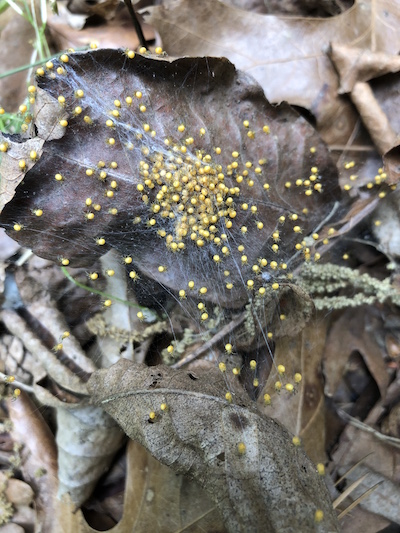
All Orb-weaver spiders should be a welcome addition to your garden or landscape because they control many common insect pests that feed on plants. Spiders in this group build the storybook, circular spider webs that are frequently seen around homes and in gardens or natural areas. There are many different species of Orb-Weaver spiders — the most familiar may be the Black and Yellow Garden Spider (Argiope aurantia). This somewhat intimidating, but harmless spider spins a web with a prominent zig-zag band of white silk (called a stabilimentum) at the very center. The stabilimentum may function to attract insects or keep birds from flying into the web.
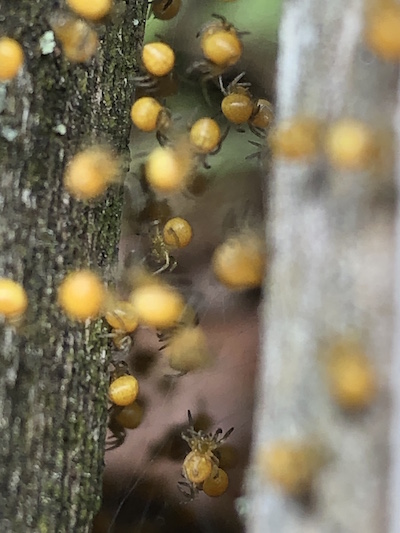
Spiders can produce up to seven distinct silk types needed for various tasks such as web-building, wrapping prey, creating areas to hide, covering egg cases and even locomotion. When spiderlings are at the right stage and environmental conditions are favorable, they produce fine silk threads (called gossamer) and become airborne through a mode of aerial dispersal called “ballooning.” Dispersal is critical to avoid being eaten by their hungry spiderling siblings. Some of these ballooning spiderlings may travel long distances, but all will hopefully land where food and shelter are available increasing their odds of survival to adulthood. You may be delighted (or disappointed if your worst nightmare is thousands of flying tiny spiders!) to learn that large numbers of spiderlings can sometimes balloon simultaneously resulting in a lovely carpet of silk covering shrubs or fields.
The History of the Hammerhead Flatworm
by Greg Skupien, Curator of the Naturalist Center
Every year we receive several Ask a Naturalist requests to identify a long, slimy worm with a wide head. At first glance these worms are noticeably different from anything in our area. The appropriately named, Hammerhead Flatworm (Bipalium kewense), is an invasive species of land planarian native to Southeast Asia. The Hammerhead Flatworm can be identified by its half-moon shaped head, pale yellow-brown color and dark stripes running along the length of the body. The largest individuals can reach up to one foot in length.
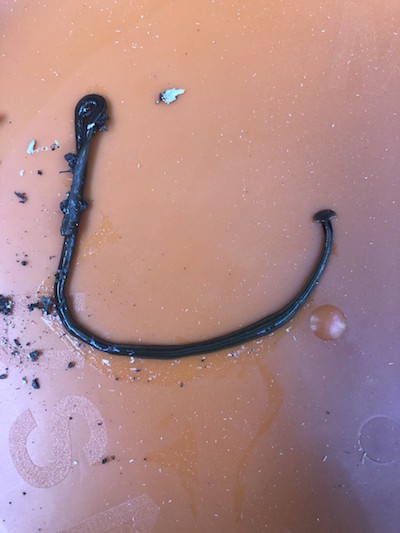
The Hammerhead Flatworm first arrived in the USA in the early 1900s through the commercial trade of horticultural plants. Once introduced into a suitable environment the flatworms can spread rapidly. Reproduction occurs primarily through fragmentation. The tip near the tail attaches to the ground and begins to separate from the “parent.” With a little effort, the pieces pull apart and one flatworm becomes two. The tip that separates is immediately active and within 7 to 10 days a head begins to form.
Hammerhead Flatworms are considered invasive because they feed on earthworms, insect larvae, and other invertebrates. They excrete a slimy substance that allows them to trap their prey. Hammerhead Flatworms can be found hunting in dark, moist areas. They are often encountered when folks turn over boards, logs, rocks, or some other type of cover.
If handled, they pose no threat to humans. Although it’s always a good idea to wash your hands after handling anything wild. Given that they are a non-native invasive species some people decide to manage (i.e. kill) them by applying salt, vinegar, or citrus oil individually. There is no form of widespread control.
Is That a Snake? Guess Again!
by Greg Skupien, Curator of the Naturalist Center
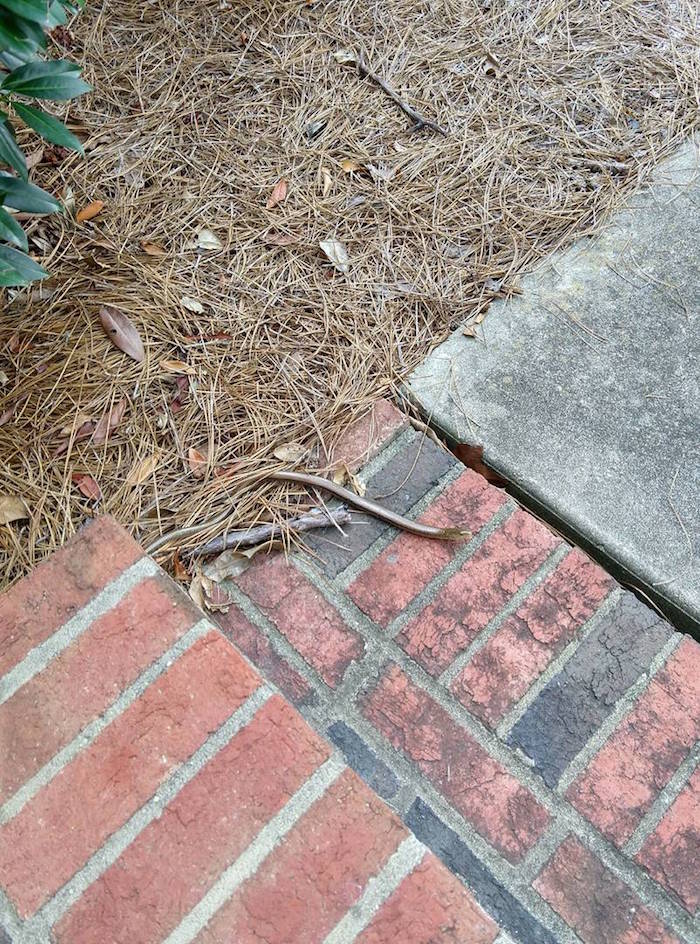
A submission to our Ask a Naturalist specimen identification form resulted in the identification of a glass lizard! Glass lizards are long, slender, legless lizards that resemble snakes. They get their name from their tendency to thrash and break off their tail when restrained by a predator (or curious human). Unlike snakes, glass lizards don’t have flexible jaws. As such, they eat smaller prey items such as insects and other invertebrates. Glass lizards also differ from snakes in that they have external ear openings and moveable eyelids.
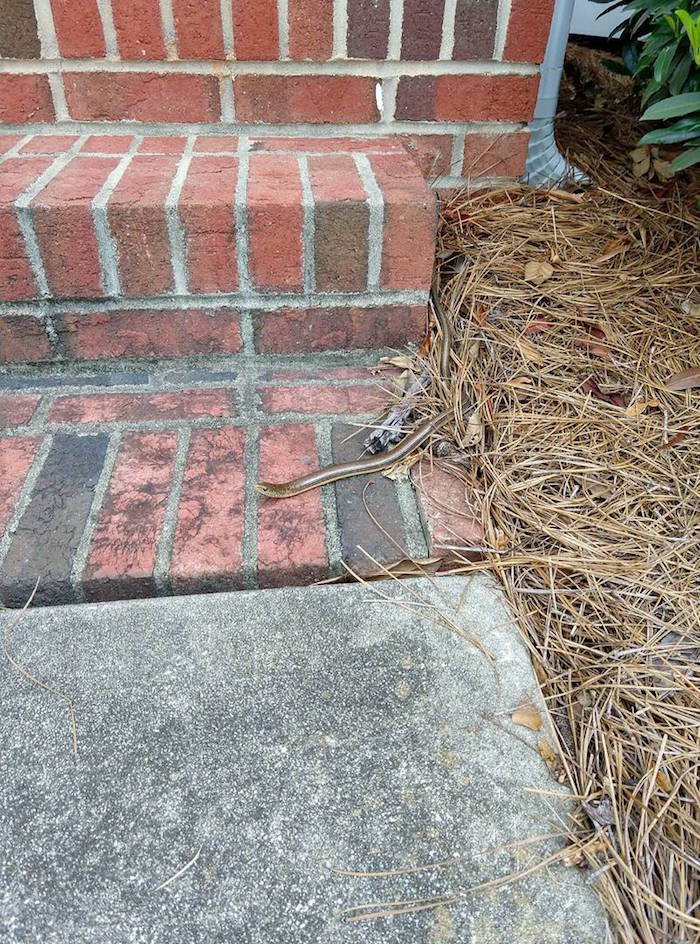
There are three species of glass lizard native to North Carolina. One such species, the Eastern Glass Lizard (Ophisaurus ventralis), typically lives in sandy habitats in the Coastal Plain of North Carolina. In July 2019, we received an “Ask a Naturalist” question from a family who found an Eastern Glass Lizard on the steps of their home in Wake Forest. At the time, there were only two other records of this species from Wake County: one was found along Crabtree Creek on June 25, 1970 and the other was found in North Raleigh on June 2, 1984. These sightings were thought to be animals that were accidentally introduced from shipments of pine straw from the coast.
Could the 2019 observation in Wake Forest be another accidental introduction? The homeowners’ association uses pine straw for the landscaping around the homes. A naturally occurring population is always a possibility. The next-nearest record of an Eastern Glass Lizard is from Nash County which isn’t too far east. Either way, this encounter remains a noteworthy sighting and has been recorded in the Museum’s files.
Identifying a Buckeye
by Cindy Lincoln, Naturalist Center Coordinator
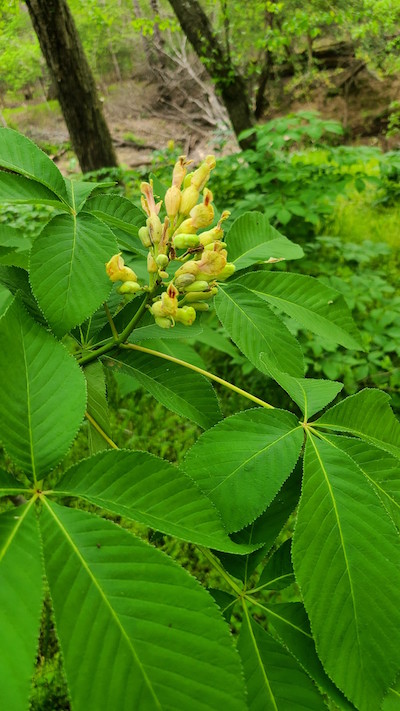
A recent question to our Ask a Naturalist specimen identification form started with this photo! We knew this had to be a buckeye because of the recognizable compound leaves each composed of five leaflets that spread out like a fan. Initially, we thought this was a Yellow Buckeye, Aesculus flava. Yellow Buckeye is a large, deciduous tree found growing in both the Piedmont and mountains of North Carolina. Typically, these trees top out at around 80 feet, but the state champion Yellow Buckeye growing in Jackson County is a whopping 139 feet tall!
But the tree in the photo could also be a Painted Buckeye, Aesculus sylvatica. Painted Buckeyes are much smaller, more shrub-like trees that only reach 10–20 feet in height. Yellow Buckeyes and Painted Buckeyes produce similar showy, upright clusters of tubular flowers that are often in shades of yellow like the blooms in the photo above. Both types of buckeyes flower from April to May in North Carolina.
So, in order to proceed with our identification, we needed more information. We asked: “What type of habitat was the tree in growing in?” “How large was the tree?” and “Can you send more photos?!”
This is the typical process for solving our Ask a Naturalist queries and often requires some serious “sleuthing” in addition to sharing submitted questions and photos with Museum experts as well as scientists and naturalists from across the State.
The follow-up photo (below) along with more details about location told us that this much shorter tree had to be Aesculus sylvatica. Painted Buckeyes prefer to grow in moist, nutrient-rich soils like those found in bottomlands and stream banks —exactly the habitat where this tree was growing.
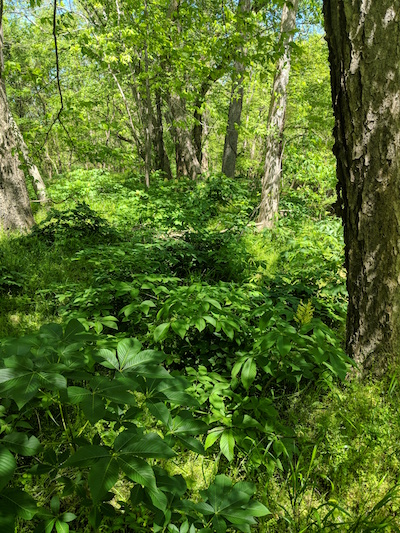
Buckeyes get their name from the shiny, hard seeds that are released from leathery, outer husks each fall. Each smooth, dark brown seed has a pale scar that some believe looks like the eye of a male deer or “buck.” Some people carry buckeye seeds as good-luck — the origins of this tradition aren’t known but may date back to the early 19th century when chestnuts (closely resembling buckeyes) were thought to possess special, curative powers. But, beware! Buckeye seeds, along with the leaves, are highly toxic to humans!
Do you have a question about a plant, animal or natural object? Be sure to Ask a Naturalist!
For more information about our upcoming activities, conservation news and ground-breaking research, follow @NaturalSciences on Instagram, Twitter and Facebook. Join the conversation with #visitNCMNS.

